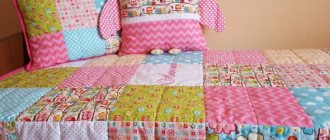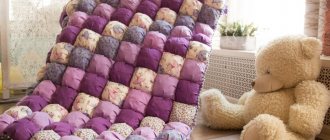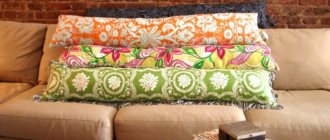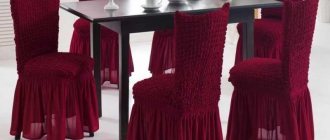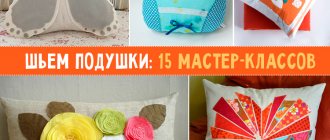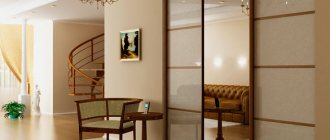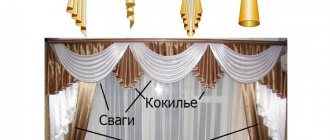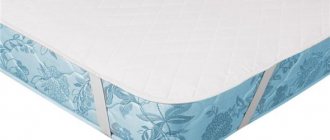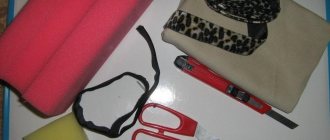Sewing a good blanket with your own hands is not a particularly difficult job, but it is painstaking. The attractive thing about it is that, having saved a considerable amount, even a novice craftswoman will be able to get something that is literally superior to store-bought ones in every way, and also unique. Try to determine where in Fig. expensive factory blanket. And how does it look in comparison with the others.
Homemade and factory-made blankets
All homemade products in Fig. made using different types of patchwork techniques, and for good reason. Most homemade quilts are scrappy. Sewing a patchwork quilt with your own hands will take a lot of time, but it will provide great opportunities for creative self-expression and means additional savings: if you are not a professional seamstress at home and you do not accumulate scraps of fabric, then its waste can be purchased at any sewing factory by weight and inexpensively . In the stores “Skillful Hands”, “Everything for Creativity”, etc. sets of scraps are sold, already sorted by color, pattern and type of fabric, specifically for sewing using the patchwork technique; They cost more than industrial waste, but not significantly. Therefore, most of the material in the article is devoted specifically to patchwork quilts, although we will also dwell on smooth-covered, modular and wicker quilts.
Dimensions
Since it is understandably difficult to make a bed for a blanket or to fit it to it, the blanket is sewn to the size of the bed. If your bed(s) are factory purchased, then blankets of one of the following sizes will fit it/them:
- Euro – 210x200 or 200x200 cm.
- Double, depending on the height and build of the couple - 210x180 (small skinny ones), 215x175 (plump short ones), 200x200 (average height and build), 220x240 (large ones).
- Single beds - 215x155 or 205x150.
- Single – 200x150.
- Children's - 150x120 (predominantly for boys) or 140x110 (more girlish).
- For newborns - the size of the changing table plus 12-15 cm in each direction. Typical size 120x120 cm.
The dimensions of the blanket for the existing bed are selected so that its edges (fringe, lace, frill, ruffle) on a made bed without lying down do not reach the floor by 12-15 cm, otherwise the edge of the blanket will get dirty. Also, the blanket on a free bed should not bunch up at the feet or heads, otherwise the insulation will creep. The size of the blanket determines the amount of materials needed for sewing.
Before sewing
Since the blanket in question is considered one of the types of patchwork, before starting work, it is important to create a diagram of the future product and work according to it.
- The essence of drawing is to form a beautiful pattern. This technique is especially important if shreds of different colors are used. Its shape can be rectangular or square.
On a note! The standard size of bombon shreds is from 8 to 40 cm. The choice of one option or another depends on the size of the product. The rule works here: the smaller the blanket, the smaller the shreds. The minimum 8-centimeter ones make it possible to fit the filler inside and at the same time correctly stitch all the elements.
Design
Sewing a blanket is simple at first glance, and this applies not only to its quilting, which will be discussed later. Have you tried washing a sweaty blanket? Say, after having the flu? If yes, then you know that it does not always fit into the machine and how difficult it is to wash it by hand. And what your work, which may have required several months of busy evenings, can turn into after it. So let's see how best to sew a blanket so that later there will be less hassle and less hassle.
A blanket, as you know, consists of a lining (underside), an insulating liner and a cover. To prevent the insulation from creeping or bunching up, the entire cake is either quilted, or the lining and the tire form a duvet cover into which the liner is placed. The last option, due to the efforts of advertisers pushing expensive products, has not been particularly popular lately, but for a homemade blanket from scraps it is advisable to consider it first, because in this case, most of the problems with washing the blanket and replacing the liner disappear. The liner always wears out faster than the tire, and washing a tire with underwear without it is equivalent to washing 2 sheets. If a window for the liner in the middle of the tire is undesirable for design reasons, then in the legs you can make a wide armhole from the lining fabric with an internal pocket-turn, like in a pillowcase. This, by the way, completely removes the problem of the reverse seam; any seamstress will immediately understand how much easier sewing is.
There is only one “but” in a blanket with a replaceable insert: if the bed does not have a footboard, then the insert will push out the pocket and the lining fabric will be visible. You can avoid this, without resorting to visible and hard fasteners of any kind, by using a wide border and/or choosing the appropriate lining material (see below). And once again, by the way, a blanket with an insert can be uninsulated for the summer. But we again ran into materials.
Positive sides
If you are seriously interested in the idea of sewing a blanket from padding polyester, you need to pay attention to the positive and negative qualities of the material. Among the advantages are its softness and airiness, heat-saving properties. Reviews of this filler often say that it is quite durable and elastic, capable of restoring its original shape. Of course, this is only possible if you choose high-quality material.
Materials
The cover of the blanket can be anything as long as it does not affect the skin and looks good. Covers for blankets for newborns, as well as for camping blankets, country blankets for hammocks, etc., used outdoors, are best made from raincoat fabrics. The cover of a thick winter blanket is made from thin furniture upholstery. For the durability of the blanket it is very important that the cover is stronger than the lining; In addition, this solution will allow you to fit the blanket into the bedroom interior. But with the lining and liner the matter is a little more complicated.
Lining
Cotton, satin or twill are most often used for the lining of the bowl; in expensive models there is silk. Cotton textiles are good for everyone, except that they get dirty easily, get sweaty and wear out pretty quickly. Therefore, cotton lining is used in blankets for children and babies born in the warm season; For the lining of a blanket for a winter-born, it is better to take calico or baize. In the era of diapers, the problem of moisture resistance from the inside, thank God, is not relevant.
Satin, twill and silk are light, durable, absolutely vapor permeable, and do not accumulate dirt. But they are slippery. Some people like it when the blanket caresses their body, while others, on the contrary, toss and turn in their pajamas underneath, still trying to fall asleep. In addition, blankets with slippery linings are not recommended for sleepyheads: they slip and become confused.
In this case, the best choice would be bamboo fabric: cotton or viscose with the addition of the finest bamboo fibers. What they write about its supposedly miraculous health and unique thermal properties is an utter lie. What can you do, marketers are, to put it mildly, peculiar people. If their boss strictly forbids them from embellishing under the threat of lifelong excommunication from corporate events and bonuses, their breath will simply stop and will not open again. However, bamboo canvas has many real advantages even without forced pushing:
- Hypoallergenic, antistatic.
- To the touch - like cotton.
- Wear resistance is an order of magnitude higher than that of cotton and almost the same as that of silk.
- High vapor permeability and very low porosity for solid particles; simply, it allows sweat to evaporate freely without accumulating dirt.
- High mechanical strength.
- It stretches weaker than even silk: if you make a lining from bamboo fabric in a blanket with a removable liner and an armhole with a pocket in the legs, the inside will not come out. In any case, a frill 5 cm wide is enough to ensure that the underside of the blanket never shows.
Liner
Blankets are most often insulated with synthetic fibrous materials: synthetic padding polyester (base is silicone, item 1 in the figure) or holofiber (base is propylene, item 2). The pads of modular blankets (see below) are conveniently stuffed with synthetic down, pos. 3. This is the same padding polyester, only not in sheets, but in the form of shaggy granules. To insulate blankets, sheet synthetic winterizer and holofiber are taken with a density of 150-200 and a thickness of 5-8 mm.
Insulation for blankets
A blanket with padding polyester insulation is lighter and cheaper than one made from holofiber, but the padding polyester cakes faster when washed. Both of these materials are warm, unusually light, harmless, incl. for small children, but their own moisture capacity is small, i.e. they sweat and become damp easily. Because The materials are non-woven, blankets with inserts made from them must be quilted, otherwise the insulation will quickly bunch up. But stitching a blanket on synthetic padding requires special techniques, because... It’s a bit thick and crawls between the lining and the tire, but at the same time it readily clings to the needle and thread.
The blanket liner is made of fleece, the same one from which jackets and warm underwear are made (item 4), is somewhat heavier and more expensive, but in return it has a lot of advantages. Fleece is a fabric, so to speak, for outdoor use, durable, warm and resistant. Its vapor and moisture permeability is heterogeneous: from the fluffy side to the dense side it is good, but on the contrary it is low, i.e. it will absorb sweat and release it, and it will be difficult for coffee spilled on the blanket to seep into the body.
Fleece does not crawl and has almost no stretch. The insert in the blanket can be made replaceable and you won’t have to worry about quilting, or you can quilt a blanket with a non-replaceable insert using a simplified, much less labor-intensive scheme, see below. In the latter case, the blanket can be washed without anything: fleece, like a woven material, is completely washable.
Last fall, the author of this publication took and replaced a jacquard camel blanket with a fleece liner (it’s cheaper than a jacket); I just needed to sew the cuts lengthwise and make an overlock. And what? The blanket became lighter, but it was no worse warm in winter. And in the off-season, when the heating was already turned off, it was too early to turn on the air conditioning and the temperature in the apartment jumped from below the sanitary standard to +27, it was equally comfortable under a blanket with a fleece liner. And for your information: a jacquard blanket made of natural six Khakassian camels measuring 210x250 at current prices will cost about 3,000 euros. Although demolition, of course, is not and is not expected in any conceivable and inconceivable operating conditions.
Patchwork
A patchwork quilt has long been sewn as a dowry for girls of marriageable age, and not at all out of poverty, but as evidence of their perseverance, hard work, skill and artistic taste; Hawthorns and princesses also sewed blankets from scraps. In the West, the latter, already in marriage, often also wove tapestries, with which the wife of William the Conqueror entered history: her creation depicts the history of the conquest of England by the Normans.
With the beginning of Soviet power, war was declared on quilts as mercilessly as on churches. At the suggestion of the well-known comrade. Inessa Armand and Alexandra Kollontai. The reason for such intolerance can be understood if we recall the latter’s “glass of water theory” and the well-known slogan that followed from it in the 20s of the last century: “The Komsomol should not refuse a Komsomol member!” In what - vol. Kollontai and Armand were sanctimoniously silent, but the ugly Komsomol orgies date back to those times.
By the way, the comrades, convinced party members, did not miss their goal. At any party meeting, activists with serious faces, but with burning impatience in their souls, awaited the “sixth question.” It was customary to consider 5 issues “on paper” at one pars meeting, and the “sixth issue” was a drunken bacchanalia afterwards.
“Promising” Komsomol activists were often involved in “considering the sixth question” if they were available. Of the current openly Nazi figures, one can find at least 10 of varying degrees of fame, during which they labored in this incarnation and firmly believed in a great bright future. His own, for sure, and only based on his natural abilities, without any outstanding abilities, great works and achievements. And then suddenly you are faced with perestroika, revelations, a turning point and a complete failure of your career. Well, how can you not go completely berserk? However, let’s put an end to what sometimes happens under the blanket and return to blankets as such.
What is required for production
Before you start sewing, you should make sure that you have all the materials and tools necessary for the work and place them within reach. If new fabric is used for sewing, it is recommended to pre-wash, dry and iron it to avoid shrinkage of the finished product.
Tools and materials:
- fabric for small “ottomans” (preferably soft and not thick);
- base material (chintz, satin or other cotton fabrics);
- filling for “ottomans” (sintepon or holofiber);
- threads to match the fabric;
- needles, pins;
- scissors, pencil, ruler;
- sewing machine.
It is not recommended to use cotton wool as a filler: in addition to the fact that the blanket will be heavy, difficulties will inevitably arise with washing the product (cotton wool tends to roll and flake).
Styles and compositions
The most labor-intensive, but also the most valuable, are the blankets sewn from random scraps and scraps. The work took years, and to assemble this chaos in a way that would look good requires remarkable abilities. For a patchwork quilt in the style of chaos (item 1 in the figure) in England, for example, connoisseurs pay up to 8,000 pounds or more.
Most often, wedges and strips remain from cutting. The first ones naturally ask for a spiral composition (pos. 2), and the stripes are used to sew patchwork quilts in the zebra or stream style, pos. 3. The latter are valued almost on an equal basis with chaotic ones, as somewhat less labor-intensive, but more spectacular.
Photos of quilt samples
Modular
Modular (block) quilts differ from “true random” quilts in that the quilts are sewn together into geometrically regular modules, which are then trimmed to a template (see picture on the right). This simplifies and speeds up the work significantly, but the value of the product in the eyes of experts is reduced, because is determined primarily by the artistic merits of the blanket. Therefore, blocks are most often sewn square. 5-, 6-gons and other figures that are compatible without gaps greatly complicate the work, but the blanket, if it wins at all, is a little spectacular.
Trimming quilt blocks using templates
Blankets in the style of “block chaos”, pos. 4 in Fig. higher, more amateur, because their labor intensity is relatively low. At auctions in the middle price segment, block-assembled patchwork quilts in the style of arable land (pos. 5) and vegetable garden, pos. 6. They are named so because they are somewhat similar to aerial photographs of this type of area. Also average, but higher, are rated blankets in the style of a patchwork meander, pos. 7, block-geometric, pos. 8 and 9, as well as chess, pos. 10 if they are made with taste and creativity.
Note: all block quilts can be sewn so-called. reversible, with transverse, longitudinal or both seams between the blocks on the face, pos. eleven.
Patchwork
Block-modular patchwork sewing is already the origin of the patchwork technique and its variety of quilting (not to be confused with paper quilling!). In prefabricated patchwork, modules (blocks) are sewn together, as in simple patchwork, and in quilting they are sewn onto a solid base. Fundamentally, patchwork differs from simple patchwork sewing in that the patches are selected in advance and prepared for the product. For example, in patchwork kits, the patches are often already cut to size and sold in kits for a specific item, with sewing and assembly patterns attached.
Photos of blankets using patchwork technique
It is not for nothing that the patchwork technique has gained worldwide popularity: with it you can create truly masterpieces of sewing art at home in almost any national and/or traditional style; See photos for some samples. Most often, a geometric assembly of blocks of regular shape is used, but zebra, stream, wave, etc. options are also possible. Patchwork does not accept visible chaos; its pattern is always semantic and organized in a certain way. If simple patchwork is closer to abstractionism in fine art, then patchwork is already a full-fledged modernist style.
Abstract art is not without deep meaning, but in addition to an outstanding master, it also needs an equally knowledgeable viewer and connoisseur. Therefore, abstraction is easily counterfeited by empty mediocrities. Modernism is also devoid of strict canons, but it shows its essence clearly and almost everyone is able to distinguish success from worthless attempts in it. This is the second important reason for the popularity of patchwork.
Schemes and blocks
Standard patchwork block sizes are from 10x10 to 30x30 cm in increments of 5 cm. Simple patterns of patchwork blocks, such as. corner spiral and ladder, you can create it yourself on checkered paper, see figure; The numbers indicate the numbers of fabric colors according to the selected samples. The block size is obtained based on the smallest permissible width of the pattern element along the face, equal to 1.5 allowances for the hem, i.e. for most fabrics 15 mm (see below, about sewing techniques).
Simple block diagrams for patchwork
How to work with diagrams
When you search for “quilt blocks”, “patchwork blocks”, “blocks for patchwork”, “blocks for patchwork”, a lot of samples come up. But these will be either simplified diagrams with alphabetical indications of the levels (upper part in the figure), or simply samples of pattern elements (below in the figure), on the basis of which you need to develop patterns in size and arrange the available flaps according to color.
Sample blocks for patchwork sewing
The development of a complete sewing pattern using the patchwork technique is carried out in stages as follows:
- Life-size diagrams of the selected blocks are built on checkered paper;
- Fabric samples are laid out according to the diagrams until the required aesthetic effect is achieved. It is advisable to operate with all selected blocks at once, this will make it easier to achieve an overall visual effect;
- The paper blank for each block is made in the quantity necessary to sew the entire item;
- On paper diagrams, the selected colors are approximately marked with colored markers;
- Paper blanks are laid out in natural size and the overall effect is assessed;
- If some block/blocks do not fit aesthetically, repeat paragraphs. 1-3;
- When the item looks as it should, the selected blocks are numbered or designated by letters so as not to be confused with the numbering of fabric samples;
- A complete drawing of the product is drawn (for samples, see the figure below) indicating the dimensions, numbering of fabrics and blocks.
The last point is a stumbling block for beginner patchwork lovers/lovers; it is often simply overlooked. And then it turns out that “the scythe went wrong” (the mow went according to geometry and color), and it is very difficult to find where the germ of the flaw is hidden in the confusion of these seemingly simple figures.
Quilt and pillow plans
About schemes for children
Additional requirements are imposed on the development of patterns for children's things using the patchwork technique, due to the characteristics of the child's not yet fully developed vision and psyche. A patchwork baby quilt, for example, should be designed as follows:
- Large blocks are undesirable; it is better to work in a 10x10 cm module.
- Small details of the pattern should not flicker; It is advisable to avoid complex curved contours.
- Larger meaningful blocks (filled with a picture) need to be alternated with smaller background ones.
- Repetitions of the same significant block in longitudinal and transverse rows are unacceptable.
- Bright, saturated, flashy colors are also unacceptable.
- The background color in quilting should be kept in the area of greatest sensitivity of children's eyes: pale yellow, light green, pale blue.
- The symmetry of the pattern relative to the longitudinal axis is very, very desirable with an odd number of longitudinal rows, i.e. there must be a central row.
An example of the correct construction of a pattern for a children's blanket - patchwork is given in Fig. Module – 10x10 cm. Full size (170x130 cm) is designed for growth. The design of significant blocks can be different, satisfying the above requirements.
Baby quilt pattern
Design options
Bonbon is a technique that implies the presence of many options for color and texture combinations in one product. You can combine ottomans or pillows in contrasting shades, or, on the contrary, you can create calm combinations. Delicate floral designs and pastoral motifs are good for a bedroom, girl's room or living room with a classic interior. Chocolate and beige make a dynamic and at the same time traditional combination that creates warmth and comfort. Wine shades add chic to the atmosphere.
If you want to create something completely unusual, metallic textures, foil-like fabric, shiny satin and crepe-satin combined with matte details will come to the rescue.
Decorative and functional model option
If the blanket is not intended for use by small children, it can be decorated with a bright edging with rhinestones or sequins.
As for the arrangement of parts by color, it all depends on the choice of the master. He prepares a scheme of color combinations in advance, thinks through how and in what quantity to place squares in a horizontal row, and makes the overall appearance of the product attractive.
Mint or lemon in combination with gray, pink in combination with gold - the color scheme of bonbon blankets can attract attention, relax the eye, and create accents. Considering the volumetric design of the product, it is not only a convenient and functional item, but also takes up enough space in the space, so it is worth thinking about its appearance in advance
The texture of the fabric can also serve as decoration
If we talk about the difference between children's and adult models, then lush-looking pillows are more appropriate for the play environment of a children's room
As for the choice of colors, all kinds of bright ottomans, juicy and eye-catching, are suitable for children. You can also opt for calmer pastel options. If the fabric has large prints with famous fairy tale and cartoon characters, you can use a pattern measuring 10 by 10 centimeters or more for the ottomans.
Other large patterns that combine with each other are also suitable.
If the fabric has large prints with famous fairy tale and cartoon characters, you can use a pattern measuring 10 by 10 centimeters or more for the ottomans. Other large patterns that combine with each other are also suitable.
For adults, the decisive factor is the overall style of the room and color in combination with the color schemes of the product.
The size of the squares may vary
Technology
Trimming flaps
This is a preparatory, but very labor-intensive and responsible operation; The allowance must be at least 7.5 mm, otherwise the seams of the tire will unravel later. To cut flaps to size and shape, stores (sewing shops, For Creativity, Skillful Hands) sell cutters and boards with a self-tightening coating; a coordinate grid is applied to their front side. The coating is rough, the fabric adheres to it.
The cutter can also be replaced with safety razor blades (3-5 per quilt), but if you are sewing a quilt in the chaos style or from chaotically assembled blocks, then it is difficult to find a replacement for the “self-healing” board. Only experienced cutters can accurately use scissors, and plywood and cardboard are quickly cut off by a cutter until they are completely unusable.
Scheme of a 7-color patchwork quilt in the flic-flac style and a template for cutting flaps for it
If you work using the patchwork technique, when one thing requires quite a few identical fragments, the matter is simpler. This is the time to hide your beloved, unless he is stuck tightly to beer and football: templates for cutting need to be cut out of plywood in the form of 2 completely identical halves with wings for an allowance. The blank flap is inserted between them (on the left in the figure), and the halves are combined. This is not difficult, because the edges of the template halves can be easily felt through the fabric. The template is then compressed with your fingers or a small carpenter's clamp.
A special cutter (not cheap, by the way) is not needed for such a template: even very thin and “stretchy” fabric can be precisely cut with a razor blade. For example, just one such composite template is enough to cut flaps for a very impressive blanket in the flik-flyak style (on the right in the figure).
Sewing and edging
Sewing the flaps together and sewing the cover of a blanket from blocks, as well as its edging, do not differ significantly from other sewing works. The amount of allowance and the minimum allowable size of the workpiece are indicated above; The simplest method of edging is bias tape. We offer a selection of videos about everything else for beginners:
How to sew flaps:
Master class on sewing a patchwork quilt with your own hands:
Blanket edging using patchwork technique:
Quilting
Quilting a warm blanket with a non-replaceable insert is an operation even more important and labor-intensive than preparing fragments. It’s better for beginners not to think about the figured stitch (wave, leaves, scales, etc.). Figured stitching of blankets is done by weight: the pie blank is unrolled horizontally in the frame, and along the seams marked in advance on the cover, all 3 layers of materials are secured with pins. Simple straight pins are best. Pieces of cork are pricked onto their points; they hold the pie firmly and protect against punctures.
Once upon a time, figured stitching was done by hand, but now special sewing machines without a table and with long consoles movable in 2 directions are used for it. This unit occupies a large room. We would prefer to make do with a regular sewing machine. Better, of course, is a machine with a walking foot, but it’s so expensive. It will be much cheaper to buy or make yourself (him, not you) a special foot for quilting for a regular sewing machine, see for example. track. video clip:
In any case, the working techniques for quilting a blanket are as follows:
- By marking the seams, the cake is secured against displacement of the layers with safety pins.
- With the spread fingers of the right hand, spread the cake over its entire thickness directly in front of the foot. If the liner is synthetic padding, this requires considerable skill.
- With the folded fingers of the left hand, they pull up the material behind the foot. Here, too, you need experience and a sense of the material in order to pull exactly in time with the feed of the fabric with the grab (teeth). If you didn’t make it, the puff wrinkled and/or the seam came off; overtightened - the thread got tangled, the needle got stuck or broke.
Note: for quilting a blanket, you need to use smooth and strong polyester thread No. 40 or No. 50.
A patchwork quilt is usually quilted with the so-called. free stitch, see e.g. video tutorial:
In general, for slippery liners made of synthetic padding polyester and holofiber using a conventional sewing machine, a linear-diagonal stitch pattern is recommended (on the left in the figure below):
- From the center to the short edges, stitch across.
- Then do the same - from the center to the long edges.
- Also from the center - diagonally to the corners.
- From the middle, parallel to any of the diagonals, alternately on one side and the other - to the opposite corners.
- The same, from the other diagonal to the remaining 2 corners.
Blanket quilting patterns
A linear-diagonal stitch does not eliminate the flaws that are inevitable when stitching on a conventional machine, but it drives them to the edges and corners where the cake can be trimmed. Therefore, if a blanket is quilted in this way, its edging and bordering are done last. If the blanket has a fleece liner, then the matter is again greatly simplified: then the blanket can be quilted with an envelope (on the right in the figure); the step of expanding the rectangles is from 10 to 25 cm (for fleece).
Bubbles
- Many people like this technique because it is easy to implement. The main trick is sewing small squares to the canvas and simultaneously filling them with padding polyester, and so on one after another.
Execution sequence:
- Mark the dense base with squares - it will serve as a guide for the boundaries of the “bubbles”.
- Prepare templates for scraps. It should be larger than the cells that are applied to the base, since with their help volume is created.
- Now you need to sew the squares in lines horizontally or vertically. This must be done with the entire number of blanks. Then iron along the seams so that they do not puff up.
- Next, the strips are sewn onto the base, and the connection lines on the bubbles should coincide with the cells on the base. The fabric that turns out to be excess needs to be folded.
- You need to do the same with the other side and secure with pins or a basting stitch. Then sew along the junction between the squares.
- In order to fill each bubble with filler, you need to leave one side unstitched. After softening, sew according to the same rules as indicated above along the seam and at the marking site on the base.
- Next, sew on the next strip and repeat the same steps with it.
Advice! You can sew on the entire array of outer fabric at once. Once completed, you need to make a cut on each pillow on the wrong side and place the filling through it, then sew it up by hand. The cut edges should be folded inward so that they do not crumble during use.
Covering yourself with such a blanket is a pleasure
Other blankets
For the little ones
An ordinary blanket for a newborn should be sewn as stated above: size 120x120 cm, summer lining cotton linen; winter - flannel, calico or flannel. The tire is made of raincoat fabric, the insulation is definitely synthetic winterizer: holofiber is rough, fleece is heavy, but synthetic winterizer will last up to 2-3 years. Quilting is required, but the technological “harmfulness” of the padding polyester in this case will not do much harm, because the thing is small and not for show.
Transformable blanket for newborns
In the wake of the general fascination with transformability (oh, if only it were a cucumber core in a full glass... just kidding), “advanced” mothers are actively interested in blankets for newborns – transformers. But what’s interesting here is that the original publication (see figure) begins with the word “theoretically,” and then it is emphasized that the meaning of this innovation is primarily economic.
What prevented the author of the idea from showing off with enthusiasm? Zippers. Imagine having zippers on the sides and at the heads of your blanket. And you wake up with prints on your side. Or, which is no better, the lock has moved and caught your hair or something else. What will it be like for the little one with his thin, delicate skin in this case?
In general, this is not a case where ergonomics can be sacrificed for functionality. Not to mention the moral significance of the thing. There are patents for wedding rings with nail clippers and beer cap wrenches, but what's the point? If you really want to save a little on the birth of your baby or put your hands into his things, then it would be better to sew a very ordinary envelope for discharge from the maternity hospital; The pattern is given in Fig. You can save it and show it to your child later: look, this is where you once all fit.
Envelope patterns for discharge
Modular
How a modular blanket is constructed and sewn/knitted is shown in Fig. Its advantage is technological simplicity, no turning seams, no precise cutting and fitting. But in general, this is a better option than a blanket for a sofa: if it’s cold in the bedroom, then the spaces between the pillows will cool the body.
Modular blankets
Practical or just pretty?
The “Bonbon” blanket is not just a unique thing, but also a practical accessory. Such a model will easily become a spectacular accent of the interior, emphasizing the sense of style of its owners. Moreover, the blanket will reliably cover and warm you.
The blanket, sewn in the bonbon style, is warm and light.
The product is truly multifunctional:
- Can be used for its intended purpose as a blanket.
- Some people prefer to use this accessory as a blanket or bedspread.
- Depending on the size, it can easily cope with the role of a cover for a chair, armchair, or ottoman.
- It quickly transforms into a blanket-cocoon, reliably covering you in an armchair or on the sofa.
- For a children's room it can be used as a rug for a baby who has just learned to sit. Tiny ottomans will soften the fall.
It can also be used as a mattress for a baby. It will reliably protect the baby from impact when falling.
